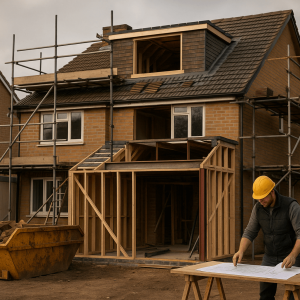Want lower bills and a warmer, greener home? Go fabric-first, seal draughts, loft to ~300 mm, smart controls, then insulate walls/floors and add PV or a heat pump (many measures 0% VAT in GB). This guide prioritises the sustainable upgrades that deliver the best returns in typical UK houses, then shows how to plan bigger improvements the right way. If you need property-specific numbers, we’ll turn your drawings into a line-item plan you can compare like-for-like: Request a Custom Estimate. Helpful reads: Tackling Rising Energy Bills, UK Building Cost Estimator, and RICS NRM – Complete Guide.
Executive Answer
Start fabric-first: seal draughts, top up loft to ~300 mm, optimise controls, then insulate walls/floors. Add low-carbon systems (heat pump, solar PV, battery, MVHR) once fabric is improved and emitters are right-sized. Many energy-saving installations in Great Britain qualify for 0% VAT, confirm with your installer. Region: UK (Great Britain). Base date: Q4 2025. VAT stance: Costs below exclude VAT unless stated. Units: m², m, mm, kWp, kWh. Currency: GBP.
Table of Contents
- Where to Start (Fabric-First Priorities)
- Sustainable Solutions by Category
- Cost Summary
- Assumptions and Methodology
- Detailed Cost Breakdown
- Programme and Durations
- Regional Variation
- Inclusions and Exclusions
- Risks and Allowances
- Key Facts & Assumptions (At a Glance)
- FAQs
- Sources
Where to Start (Fabric-First Priorities)
- Stop the leaks: draught-proof external doors/letterboxes/loft hatches and obvious gaps.
- Top up loft insulation to ~270–300 mm; board a simple service walkway.
- Smart controls: programmable thermostat, TRVs and sensible schedules.
- Insulate walls/floors: cavity fill where suitable; internal/external wall insulation for solid walls; insulate suspended timber floors.
- Then add systems: right-sized heat pump, solar PV (3–5 kWp typical), optional battery, and MVHR in airtight refurbishments.
Sustainable Solutions by Category
Insulation & Airtightness
Loft top-ups and cavity wall insulation offer the best £-per-kWh saved. For solid walls, choose internal (IWI) or external (EWI); detail moisture and ventilation carefully.
Heating & Hot Water
Air-source heat pumps work well in insulated homes with low-temperature emitters. Ground-source gives higher efficiencies but needs ground works. Solar thermal can support hot water; often PV + heat pump + cylinder scheduling is more flexible.
On-site Generation & Storage
Solar PV reduces grid import; a battery helps shift usage. Smart tariffs can improve payback if you can charge off-peak and use later.
Ventilation (MVHR)
In airtight refurbishments, MVHR provides fresh filtered air with heat recovery. Design and commissioning matter, treat as a complete system, not a bolt-on.
Glazing Upgrades
Modern high-performance double or triple glazing cuts heat loss and improves comfort; consider whole-frame performance, not just glass centre values.
Cost Summary
Indicative ranges for typical UK homes at Q4 2025, ex VAT.
- Loft top-up to ~300 mm: £12–£25 per m²
- Cavity wall insulation: £12–£22 per m² (subject to survey)
- Internal wall insulation (solid wall): £90–£150 per m²; External: £120–£200 per m²
- Underfloor insulation (suspended timber): £30–£60 per m²
- ASHP system (installed): £7,000–£13,000; GSHP: £16,000–£28,000
- Solar PV: £1,200–£1,700 per kWp (3–5 kWp typical)
- Battery storage: £500–£900 per kWh usable capacity
- MVHR (whole house): £3,500–£7,500
- High-performance glazing replacement: £450–£900 per m²
- Smart thermostat + TRVs: £180–£450 plus install
Assumptions and Methodology
We follow a fabric-first approach aligned to UK guidance: reduce demand (insulation/airtightness), then improve systems and controls, then add renewables. Cost ranges include materials, labour, preliminaries, OHP and typical risk allowances for domestic work. VAT varies: many energy-saving installations are 0% VAT in GB; confirm eligibility and ensure the invoice reflects the correct rate.
Detailed Cost Breakdown
Use this table to scope discussions and sanity-check quotes. Ranges are GB-wide, ex VAT, base date Q4 2025.
| Measure | Unit | Low £ | High £ | Typical £ | Base date | Notes |
|---|---|---|---|---|---|---|
| Loft insulation top-up to ~300 mm | m² | 12 | 25 | 18 | Q4 2025 | Include walkway boarding |
| Cavity wall insulation | m² | 12 | 22 | 18 | Q4 2025 | Subject to survey/vent details |
| Internal wall insulation (IWI) | m² | 90 | 150 | 120 | Q4 2025 | Service moves extra |
| External wall insulation (EWI) | m² | 120 | 200 | 160 | Q4 2025 | System and finish drive cost |
| Underfloor insulation (suspended timber) | m² | 30 | 60 | 45 | Q4 2025 | Access via crawl space |
| Air-source heat pump (ASHP) | each | 7000 | 13000 | 10000 | Q4 2025 | Includes install; emitter upgrades vary |
| Ground-source heat pump (GSHP) | each | 16000 | 28000 | 22000 | Q4 2025 | Borehole/ground works dependent |
| Solar PV array | kWp | 1200 | 1700 | 1450 | Q4 2025 | 3–5 kWp typical; access/roof type |
| Battery storage | kWh | 500 | 900 | 700 | Q4 2025 | Brand/warranty affects cost |
| MVHR (whole house) | each | 3500 | 7500 | 5500 | Q4 2025 | Design & commissioning key |
| High-performance glazing | m² | 450 | 900 | 675 | Q4 2025 | Frame/spec & install complexity |
| Smart controls (thermostat + TRVs) | set | 180 | 450 | 300 | Q4 2025 | Excludes complex rewiring |
Programme and Durations
- Draught-proofing & controls: same day.
- Loft top-up: 0.5–1 day (typical 40–60 m²).
- Cavity wall insulation: 0.5–1 day (subject to survey).
- IWI/EWI: several days to weeks depending on area and finishes.
- Underfloor insulation: 1–2 days per room; whole-house varies.
- Solar PV: 1–2 days for 3–5 kWp; scaffolding adds lead-time.
- Heat pumps: 2–5 days plus commissioning; allow time for emitter upgrades.
- MVHR: install typically alongside refurb; commissioning at completion.
Regional Variation
London & the South East often sit at the upper end of ranges; rural installs can add travel/scaffold costs. Roof complexity, electrical upgrades and chosen finishes also drive differences.
Inclusions and Exclusions
Included
- Materials, labour, preliminaries, typical installer OHP for domestic work.
- Basic making-good for insulation; standard electrical connections for PV/controls.
Excluded (allow separately)
- Major re-wires, consumer unit upgrades, asbestos removal, complex scaffolds.
- Planning/heritage consents, detailed design/coordination, structural works.
- Hidden defects uncovered during works (damp remediation, timber repairs).
- VAT unless stated; check 0% VAT eligibility on energy-saving materials in GB.
Risks and Allowances
- Surveys first: heat-loss, moisture/condensation risk (IWI/EWI), roof and electrics for PV.
- Price validity: components (inverters, heat pumps) have limited quote windows—capture validity dates.
- Contingency: 5–10% for straightforward installs; 10–15% where access or fabric condition is uncertain.
- Inflation: apply from base date to mid-point of works if lead-in is long.
Cost disclaimer: Ranges reflect typical GB domestic conditions at Q4 2025. Always confirm suitability and obtain written quotes aligned to your property and scope.
Key Facts & Assumptions (At a Glance)
- Fabric-first order: draughts → loft → controls → walls/floors → systems (PV/heat pump/MVHR).
- Indicative costs (ex VAT): loft £12–£25/m²; cavity £12–£22/m²; IWI £90–£150/m²; EWI £120–£200/m²; PV £1,200–£1,700/kWp; ASHP £7k–£13k; battery £500–£900/kWh.
- VAT: many energy-saving installs are 0% VAT in GB—confirm eligibility and ensure invoices reflect it.
- Units & currency: m², m, mm, kWp, kWh; GBP; base date Q4 2025.
- Tailored plan: upload drawings to Request a Custom Estimate.
FAQs
What’s the best order to upgrade my home sustainably?
Fabric first: draughts, loft, controls, then walls/floors. Add PV and/or a right-sized heat pump once demand is reduced.
Do I need new radiators for a heat pump?
Often yes. Low-temperature systems need larger emitters. A room-by-room heat-loss calc confirms sizes and flow temperatures.
Is external wall insulation better than internal?
EWI gives whole-wall performance and fewer thermal bridges but costs more and changes the façade. IWI is less disruptive externally but needs careful moisture detailing.
How big should my PV system be?
Match array size to roof, budget and daytime use. Many homes fit 3–5 kWp; batteries help if you have evening demand or want to use off-peak tariffs.
Can I get 0% VAT on energy-saving measures?
In Great Britain many qualifying energy-saving installations are zero-rated. Confirm eligibility with your installer and keep evidence.
Who should install these measures?
Use accredited installers (e.g., TrustMark/MCS for low-carbon tech). Good surveys, design and commissioning are crucial for performance.
Next step: Want a property-specific upgrade plan with costs you can compare like-for-like? Request a Custom Estimate.











